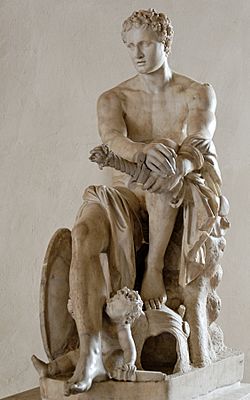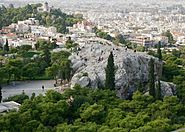Ares facts for kids
Quick facts for kids Ares |
|
|---|---|
| God of war and courage | |
| Member of the Twelve Olympians | |

The Ludovisi Ares, a Roman statue showing the god in a moment of rest.
|
|
| Abode | Mount Olympus, temples in mainland Greece, Crete and Asia minor |
| Planet | Mars |
| Symbols | Sword, spear, shield, helmet |
| Day | Tuesday (hēméra Áreōs) |
| Personal information | |
| Consort | Aphrodite |
| Children | the Erotes (Eros and Anteros), Phobos, Deimos, Phlegyas, Harmonia, Enyalius, Thrax, Oenomaus, Cycnus, and the Amazons |
| Parents | Zeus and Hera |
| Siblings | Hephaestus, Eileithyia, Hebe and several paternal half-siblings |
| Roman equivalent | Mars |
Ares (Ancient Greek: Ἄρης, Árēs) is the ancient Greek god of war and courage. He was one of the famous Twelve Olympians who lived on Mount Olympus and was the son of Zeus and Hera.
The ancient Greeks had mixed feelings about Ares. He represented the bravery and physical strength needed to win in battle. But he could also be a symbol of pure violence and anger. This made him very different from his sister, Athena. She was also a goddess of war, but she represented strategy, wisdom, and leadership in battle.
While Ares was a major god, he doesn't appear in as many myths as others, and when he does, he is often shown getting into trouble or being defeated. His Roman counterpart, Mars, was much more respected and seen as a noble protector of the Roman people.
Contents
Who Was Ares?
Ares loved conflict and the noise of battle. His personality was often described as aggressive and destructive. Because of this, even his own father, Zeus, said in the epic poem the Iliad that Ares was the most hateful of all the gods.
The Greeks often connected Ares with a region called Thrace, which they thought of as a wild and warlike place. They believed Thrace was Ares's birthplace and where he would go to cool off after a defeat or embarrassment.
Symbols of the War God
Ares was almost always shown as a warrior. His main symbols were his instruments of war:
- A bronze helmet
- A shield
- A sword or a spear
His sacred animal was the dog, and his bird was the vulture.
Ares vs. Mars: Greek and Roman Views
The Romans also had a god of war, whom they called Mars. When the Romans learned about Greek culture, they connected Mars with Ares. However, the two gods were seen very differently.
- Ares was often feared by the Greeks. They saw him as a symbol of the chaos and bloodshed of war.
- Mars was highly honored by the Romans. He was seen as a dignified protector of Rome and a father to the Roman people. According to legend, he was the father of Romulus and Remus, the founders of Rome.
Because of this, Mars was a much more important and respected figure in Roman religion than Ares was in Greek religion.
Myths and Legends of Ares
Ares appears in several famous Greek myths, where he often shows his fierce nature but also faces humiliation.
The Founding of Thebes
Ares played a key role in the story of how the city of Thebes was founded. The hero Cadmus killed a giant water-dragon that was sacred to Ares. On Athena's advice, Cadmus planted the dragon's teeth in the ground.
From the teeth, a group of fierce, fully-armed warriors called the Spartoi sprang up and began fighting each other until only five were left. These five helped Cadmus build the city of Thebes. To make peace with Ares for killing his dragon, Cadmus married Harmonia, the daughter of Ares and Aphrodite.
Ares and Aphrodite
One of the most famous stories about Ares is his relationship with Aphrodite, the goddess of love and beauty. Aphrodite was married to Hephaestus, the god of blacksmiths and crafts.
When Hephaestus learned that Ares and Aphrodite were meeting in secret, he decided to teach them a lesson. He built a magical net that was as fine as a spider's web but incredibly strong. He set a trap, and the next time Ares and Aphrodite met, the net fell and trapped them.
Hephaestus then called all the other gods on Mount Olympus to come and see the trapped pair. The other gods laughed at them, which greatly embarrassed Ares. Once he was freed, he fled to his homeland of Thrace.
Ares in the Trojan War
In the story of the Trojan War, told in the Iliad, Ares did not have a fixed loyalty. At first, he promised his mother Hera and his sister Athena that he would help the Greeks. But Aphrodite, who supported the Trojans, convinced him to switch sides.
During one battle, the Greek hero Diomedes saw Ares fighting alongside the Trojans. With help from Athena, Diomedes threw his spear and wounded the god of war. Ares let out a cry so loud that it shook both armies. He then flew back to Mount Olympus to complain to Zeus, but Zeus offered him little sympathy. Later in the war, Ares tried to fight Athena to get revenge, but she easily defeated him by hitting him with a large boulder.
Trapped in a Jar
An old myth tells of a time when Ares was defeated by two giants, the Aloadae. They captured him and trapped him in a large bronze jar for thirteen months.
Ares might have been stuck there forever if the giants' stepmother had not told the god Hermes. Hermes snuck in and rescued Ares, who was weak and tired from his long imprisonment. This story shows that even the powerful god of war could be defeated.
Family and Companions
Ares was the son of Zeus and Hera, the king and queen of the gods.
With Aphrodite, he had several children who often accompanied him. His most famous children were:
These two sons often rode with him into battle in his war chariot.
Ares was also often seen with his sister Eris (Discord) and the war goddess Enyo.
Worship of Ares
Compared to other Olympians, Ares did not have many temples in ancient Greece. However, he was still an important god, especially in warlike cities like Sparta.
In Athens, there is a rocky hill near the Acropolis called the Areopagus ("Hill of Ares"). According to myth, this is where Ares was put on trial by the gods for killing a son of Poseidon. The hill later became the site of a real court in ancient Athens.
The Spartans had a unique way of worshipping Ares. They had a statue of the god in chains. They believed that by chaining the statue, they could keep the spirit of war and victory from ever leaving their city.
Genealogy
| Ares's family tree | |||||||||||||||||||||||||||||||||||||||||||||||||||||||||||||||||||||||||||||||||||||||||||||||||||||||||||||||||||||||||||||||||||||||||||||||||||||||||||||||||||||||||||||||||||||||||||||||||||||||||||||||||||||||||||||||||||||||||||||||||||||||||||||||||||||||||||||||||||||||||||||||||||||||||||||||||||||||||||||||||||||||||||||||||||||||||||||||||||||||||||||||||||||||||||||||||||||||||||||||||||||||||||||||||||||||||||||||||||||||||||||||||||||||||||||||||||||||||||||||||||||||||||||||||||||||||||||||||||||||||||||||||||||||||||||||||||||||||||||||||||||||||||||||||||||||||||||||||||||||||||||||||||||||||||||||||||||||||||||||||||||||||||||||||||||||||||||||||||||||||||||||||||||||||||||||||||||||||||||||||||||||||||||||||||||||||||||||||||||||||||||||||||||||||||||||||||||||||||||||||||||||||||||||||||||||||||||||||||||||||||||||||||||||||||||||||||||||||||||||||||||||||||||||||||||||||||||||||||||||||||||||||||||||||||||||||||||||||||||||||||||||||||||||||||||||||||||||||||||||
|---|---|---|---|---|---|---|---|---|---|---|---|---|---|---|---|---|---|---|---|---|---|---|---|---|---|---|---|---|---|---|---|---|---|---|---|---|---|---|---|---|---|---|---|---|---|---|---|---|---|---|---|---|---|---|---|---|---|---|---|---|---|---|---|---|---|---|---|---|---|---|---|---|---|---|---|---|---|---|---|---|---|---|---|---|---|---|---|---|---|---|---|---|---|---|---|---|---|---|---|---|---|---|---|---|---|---|---|---|---|---|---|---|---|---|---|---|---|---|---|---|---|---|---|---|---|---|---|---|---|---|---|---|---|---|---|---|---|---|---|---|---|---|---|---|---|---|---|---|---|---|---|---|---|---|---|---|---|---|---|---|---|---|---|---|---|---|---|---|---|---|---|---|---|---|---|---|---|---|---|---|---|---|---|---|---|---|---|---|---|---|---|---|---|---|---|---|---|---|---|---|---|---|---|---|---|---|---|---|---|---|---|---|---|---|---|---|---|---|---|---|---|---|---|---|---|---|---|---|---|---|---|---|---|---|---|---|---|---|---|---|---|---|---|---|---|---|---|---|---|---|---|---|---|---|---|---|---|---|---|---|---|---|---|---|---|---|---|---|---|---|---|---|---|---|---|---|---|---|---|---|---|---|---|---|---|---|---|---|---|---|---|---|---|---|---|---|---|---|---|---|---|---|---|---|---|---|---|---|---|---|---|---|---|---|---|---|---|---|---|---|---|---|---|---|---|---|---|---|---|---|---|---|---|---|---|---|---|---|---|---|---|---|---|---|---|---|---|---|---|---|---|---|---|---|---|---|---|---|---|---|---|---|---|---|---|---|---|---|---|---|---|---|---|---|---|---|---|---|---|---|---|---|---|---|---|---|---|---|---|---|---|---|---|---|---|---|---|---|---|---|---|---|---|---|---|---|---|---|---|---|---|---|---|---|---|---|---|---|---|---|---|---|---|---|---|---|---|---|---|---|---|---|---|---|---|---|---|---|---|---|---|---|---|---|---|---|---|---|---|---|---|---|---|---|---|---|---|---|---|---|---|---|---|---|---|---|---|---|---|---|---|---|---|---|---|---|---|---|---|---|---|---|---|---|---|---|---|---|---|---|---|---|---|---|---|---|---|---|---|---|---|---|---|---|---|---|---|---|---|---|---|---|---|---|---|---|---|---|---|---|---|---|---|---|---|---|---|---|---|---|---|---|---|---|---|---|---|---|---|---|---|---|---|---|---|---|---|---|---|---|---|---|---|---|---|---|---|---|---|---|---|---|---|---|---|---|---|---|---|---|---|---|---|---|---|---|---|---|---|---|---|---|---|---|---|---|---|---|---|---|---|---|---|---|---|---|---|---|---|---|---|---|---|---|---|---|---|---|---|---|---|---|---|---|---|---|---|---|---|---|---|---|---|---|---|---|---|---|---|---|---|---|---|---|---|---|---|---|---|---|---|---|---|---|---|---|---|---|---|---|---|---|---|---|---|---|---|---|---|---|---|---|---|---|---|---|---|---|---|---|---|---|---|---|---|---|---|---|---|---|---|---|---|---|---|---|---|---|---|---|---|---|---|---|---|---|---|---|---|---|---|---|---|---|---|---|---|---|---|---|---|---|---|---|---|---|---|---|---|---|---|---|---|---|---|---|---|---|---|---|---|---|---|---|---|---|---|---|---|---|---|---|---|---|---|---|---|---|---|---|---|---|---|---|---|---|---|---|---|---|---|---|---|---|---|---|---|---|---|---|---|---|---|---|---|---|---|---|---|---|---|---|---|---|---|---|---|---|---|---|---|---|---|---|---|---|---|---|---|---|---|---|---|---|---|---|---|---|---|---|---|---|---|---|---|---|---|---|---|---|---|---|---|---|---|---|---|---|---|---|---|---|---|---|---|---|---|---|---|---|---|---|---|---|---|---|---|---|---|---|---|---|---|---|---|---|---|---|---|---|---|---|---|---|---|---|---|---|---|---|---|---|---|---|---|---|---|---|---|---|---|---|---|---|---|---|---|---|---|---|---|---|---|---|---|---|---|---|---|---|---|---|---|---|---|---|---|---|---|---|---|---|---|---|---|---|---|---|---|---|---|---|---|---|---|---|---|---|---|---|---|---|---|---|---|---|---|---|---|---|---|---|---|---|---|---|---|---|---|---|---|---|---|---|---|---|---|---|---|---|---|---|---|---|---|---|---|---|---|---|---|---|---|---|---|---|---|---|---|---|---|---|---|---|---|---|---|---|---|---|---|---|---|---|---|---|---|---|---|
|
|||||||||||||||||||||||||||||||||||||||||||||||||||||||||||||||||||||||||||||||||||||||||||||||||||||||||||||||||||||||||||||||||||||||||||||||||||||||||||||||||||||||||||||||||||||||||||||||||||||||||||||||||||||||||||||||||||||||||||||||||||||||||||||||||||||||||||||||||||||||||||||||||||||||||||||||||||||||||||||||||||||||||||||||||||||||||||||||||||||||||||||||||||||||||||||||||||||||||||||||||||||||||||||||||||||||||||||||||||||||||||||||||||||||||||||||||||||||||||||||||||||||||||||||||||||||||||||||||||||||||||||||||||||||||||||||||||||||||||||||||||||||||||||||||||||||||||||||||||||||||||||||||||||||||||||||||||||||||||||||||||||||||||||||||||||||||||||||||||||||||||||||||||||||||||||||||||||||||||||||||||||||||||||||||||||||||||||||||||||||||||||||||||||||||||||||||||||||||||||||||||||||||||||||||||||||||||||||||||||||||||||||||||||||||||||||||||||||||||||||||||||||||||||||||||||||||||||||||||||||||||||||||||||||||||||||||||||||||||||||||||||||||||||||||||||||||||||||||||||||
See also
 In Spanish: Ares para niños
In Spanish: Ares para niños
- Family tree of the Greek gods


